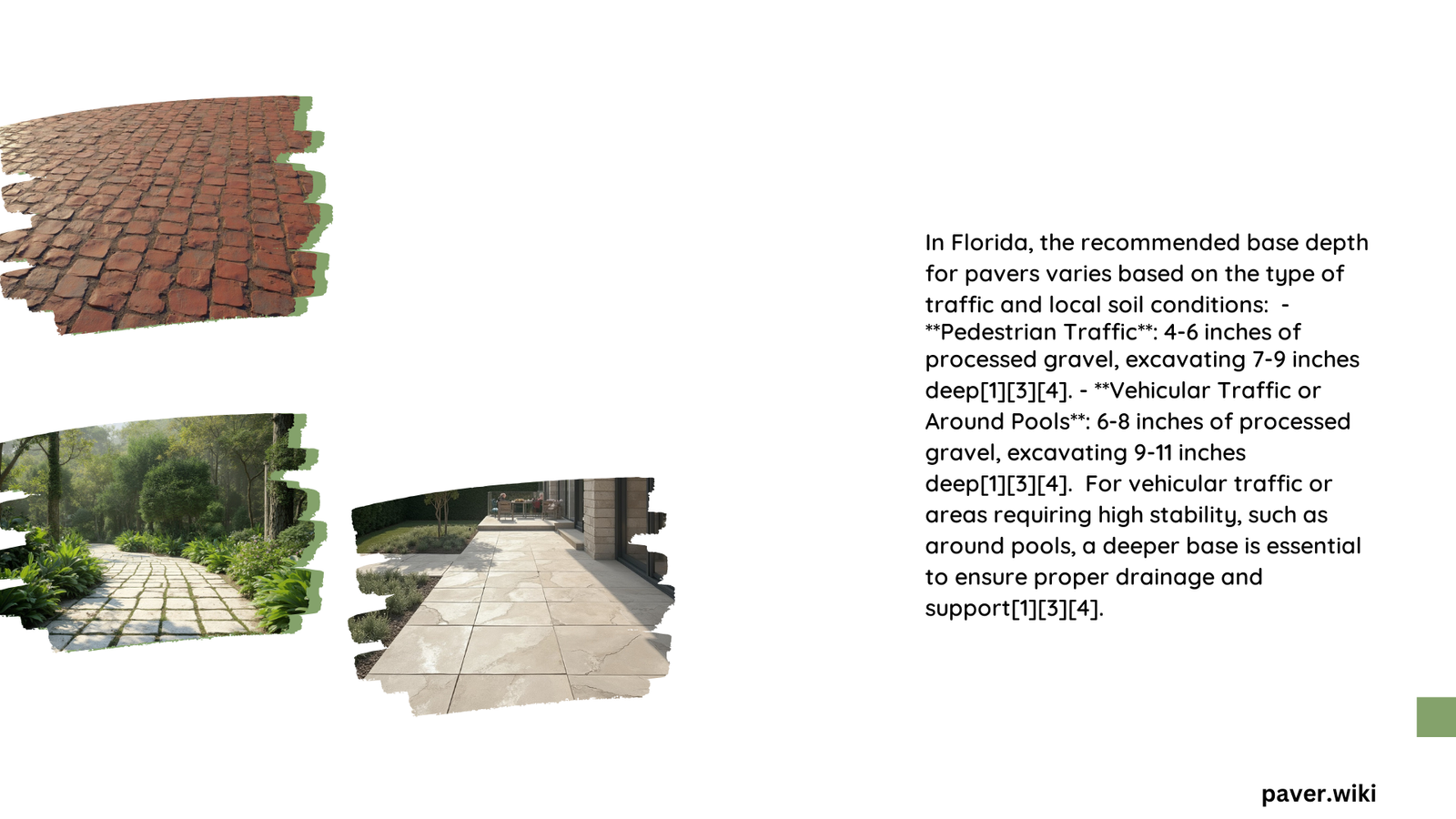The depth of a paver base in Florida is crucial for ensuring stability and longevity of your hardscape project. In Florida’s unique climate and soil conditions, proper base preparation is essential. Typically, pedestrian areas require a 4-6 inch compacted gravel base, while vehicular areas need 8-12 inches. Factors like soil type, drainage, and intended use influence the exact depth. This guide will provide comprehensive insights into determining the ideal base depth for your Florida paver project.
What Are the Recommended Base Depths for Different Paver Applications in Florida?
The base depth for pavers in Florida varies depending on the intended use of the area:
- Pedestrian walkways and patios:
- 4-6 inches of compacted gravel base
-
Total excavation depth: 7-8 inches below finished grade
-
Driveways and vehicular traffic areas:
- 8-12 inches of compacted gravel base
- Total excavation depth: 9-13 inches below finished grade
These recommendations account for Florida’s climate, which lacks freezing temperatures but requires excellent drainage due to frequent rainfall.
Why Is Proper Drainage Crucial for Paver Bases in Florida?

Effective drainage is paramount in Florida’s paver installations due to the state’s high rainfall and potential for water accumulation. Here are key considerations:
- Slope requirements:
- Minimum slope: 1% to 2%
- Translates to a ½ inch fall in 4 feet
-
Use a level with a spacer to set the correct slope
-
Drainage materials:
- Geotextile fabric: Recommended for poor soil drainage or high clay content
- Gravel base: Use crushed stone or gravel with a mix of fine and coarse aggregate
- Preferred materials: 3/4″-0 or ODOT road base gravel
Proper drainage prevents water pooling, which can lead to erosion, settling, and damage to the paver installation over time.
How Does Florida’s Soil Affect Paver Base Preparation?
Florida’s soil characteristics significantly impact paver base preparation:
- High clay content:
- Requires deeper excavation
-
Necessitates the use of geotextile fabric
-
Sandy soil:
- May require less excavation
-
Still needs proper compaction to prevent settling
-
Organic soils:
- May need complete removal and replacement with suitable base material
It’s crucial to assess your specific soil type and consult with local experts to determine the best approach for your paver project.
What Are the Steps for Proper Soil Preparation in Florida?
Follow these steps for effective soil preparation:
- Excavation:
- For pedestrian areas: 7-8 inches below finished grade
-
For vehicular areas: 9-13 inches below finished grade
-
Geotextile fabric installation (if needed):
- Lay fabric at the bottom of the excavated area
-
Helps prevent base material from sinking into soil
-
Gravel base installation:
- Spread in layers of 2-4 inches
-
Compact each layer thoroughly
-
Sand bedding:
- Add a 1-inch layer of concrete sand
- Level and screed the sand
Proper soil preparation ensures a stable foundation for your pavers and prevents future settling or shifting.
How Do Local Soil Types in Florida Challenge Paver Base Installation?
Florida’s diverse soil types present unique challenges:
- Clay soils:
- Retain water, leading to poor drainage
-
Require deeper excavation and geotextile fabric
-
Sandy soils:
- Drain quickly but may lack stability
-
Need proper compaction to prevent settling
-
Organic soils:
- Unsuitable for direct paver installation
-
May require complete removal and replacement
-
Limestone:
- Common in some Florida regions
- May require specialized excavation techniques
Understanding your local soil type is crucial for determining the appropriate base depth and preparation methods.
What Are the Cost Implications of Proper Paver Base Preparation in Florida?
Proper base preparation is an investment in the longevity of your paver installation. Here’s a breakdown of potential costs:
- Material costs (for a 100 square foot patio):
- Crushed stone or gravel: $200-$400
- Sand: $50-$100
- Geotextile fabric (if needed): $50-$100
-
Total material cost: $400-$700
-
Labor costs:
- Vary depending on project size and complexity
-
Professional installation recommended for optimal results
-
Equipment rental (if DIY):
- Plate compactor: $50-$100 per day
- Excavation equipment: $100-$200 per day
While proper base preparation may increase initial costs, it significantly reduces long-term maintenance expenses and extends the life of your paver installation.
How Long Does Paver Base Preparation Take in Florida?
The timeframe for paver base preparation can vary based on several factors:
- Project size:
- Small patio (100 sq ft): 1-2 days
-
Large driveway (1000 sq ft): 3-5 days
-
Soil conditions:
-
Clay or organic soils may require additional time for proper preparation
-
Weather conditions:
-
Florida’s frequent rainfall can cause delays
-
Complexity of the project:
- Intricate designs or slopes may require more time
It’s crucial to allocate sufficient time for base preparation, as rushing this step can lead to future problems with your paver installation.
What Are the Key Differences in Paver Base Requirements for Florida Compared to Other States?
Florida’s unique climate and soil conditions necessitate specific paver base requirements:
- Frost considerations:
- Florida: No need for deep frost protection
-
Northern states: Require deeper bases to prevent frost heave
-
Drainage focus:
- Florida: Emphasis on rapid water drainage due to frequent rainfall
-
Drier states: May require less intensive drainage solutions
-
Soil types:
- Florida: Often deals with sandy or clay soils
-
Other states: May have different predominant soil types
-
Compaction requirements:
- Florida: Crucial due to potential for soil settling
- Rocky regions: May require less intensive compaction
Understanding these differences is essential for adapting paver base techniques to Florida’s specific needs.
In conclusion, determining the appropriate depth for a paver base in Florida requires careful consideration of various factors, including soil type, intended use, and local climate conditions. By following these guidelines and consulting with local experts, you can ensure a stable, long-lasting paver installation that withstands Florida’s unique environmental challenges.
